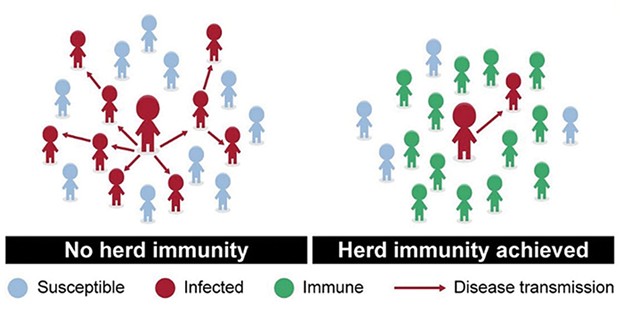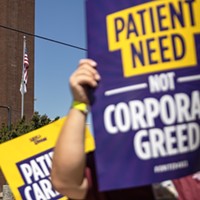
(General Services Administration and National Institutes of Health)
Herd immunity is achieved when immunity reaches a high-enough percentage to stem the spread of a disease.
[
{
"name": "Top Stories Video Pair",
"insertPoint": "7",
"component": "17087298",
"parentWrapperClass": "fdn-ads-inline-content-block",
"requiredCountToDisplay": "1"
}
]
We've been hearing a lot about the holy grail of herd immunity lately, especially with the introduction of vaccines to counter COVID-19 and a general sense of seeing the light at the end of this yearlong tunnel. As soon as we've achieved herd immunity, goes the meme, we're out of the woods (to mix my metaphors) and normal life can resume. There are, however, a couple of caveats we should keep in mind before we relax our guard, trash our masks and party on.
Immunity is the body's ability to resist pathogens, such as viruses or bacteria. We acquire immunity either through vaccination or through natural immunity, when a person gets the disease and survives. In either case, the body's response is the same: It manufactures proteins known as antibodies that recognize and destroy the pathogens, leading to both immunity and a check on transmitting the disease to others.
While the concept of herd immunity is nearly 100 years old, its role in slowing the spread of disease was only fully recognized in the 1960s with the increasing use of vaccines. The idea is pretty straightforward: If a sufficient percentage of a population acquires immunity to a disease, its exponential spread will be stemmed for lack of vulnerable hosts. That percentage depends critically on how infectious the disease is, as measured by R0 ("R-nought"), the number of people, on average, that an infected person will go on to infect. Some viruses have a high R0 number, i.e. they're very infectious, such as the measles virus, with an R0 between 12 and 18. That is, one person with measles will infect 12-18 other people on average. At the other end of the spectrum, the R0 value for influenza is 1.5-1.8. The critical number is 1.0; once R0 drops below unity, the spread is stemmed and disease tapers off.
The link between R0 and herd immunity was formally established in the 1970s with a simple formula. If the proportion of people needing to be immune to stop ongoing transmission of the disease is the "herd immunity threshold," or HIT, then HIT = 1 – 1/R0. In the case of measles, the HIT is 92-95 percent, while for influenza it's 33-44 percent. In the case we're all interested in, COVID-19, R0 is about 3 (ranging from 2.5 to 4), meaning that 1-1⁄3, or 67 percent, of the population needs to be immune for transmission to be stemmed. That 67 percent acts as proxy for those for whom a vaccine may be harmful, such as the very young, the very old and people who are immuno-compromised. And that's not even counting anti-vaxxers. Now the caveats:
Caveat 1: The elephant in the room is that this all assumes homogeneity, that is, that we're all typical all the time, that we all mix with the same number of people, that we all take the same precautions to avoid getting or spreading COVID-19, and that we're all equally vulnerable to the virus. But real life isn't uniform — we tend to cluster in our own social networks, some us wear our masks religiously while others don't at all, and there's a huge disparity in how easily an individual can get infected. For instance, if your network includes any "super-spreaders," your risk of getting infected goes up proportionally, of course.
Caveat 2: Getting R0 below 1 is the first goal but that doesn't mean we can all relax. The disease is still spreading but not exponentially as before. Instead, fewer and fewer people will get infected as time goes by, but many people are still vulnerable, at least until the disease is eradicated. And good luck with that! The only case where complete eradication has happened is with smallpox (last recorded case in 1977, in Somalia). Of some 80 potential disease candidates, an international task force concluded that, realistically, only six could be completely eradicated.
In the long run, we will achieve large-scale herd immunity against COVID-19, not just in Humboldt County or even the U.S., but globally. But that will only come about when enough of us have been vaccinated. I can't wait.
Barry Evans ([email protected]) is an anti-anti-vaxxer. Not just for himself, but also for everyone he comes into contact with.
Speaking of...
Comments
Showing 1-1 of 1
more from the author
-
The Other Evolutionist
- Jul 25, 2024
-
Rise and Fall of the "Sunshine Vitamin," Part Two
- Jul 11, 2024
-
Rise and Fall of the 'Sunshine Vitamin,' Part One
- Jul 4, 2024
- More »



































